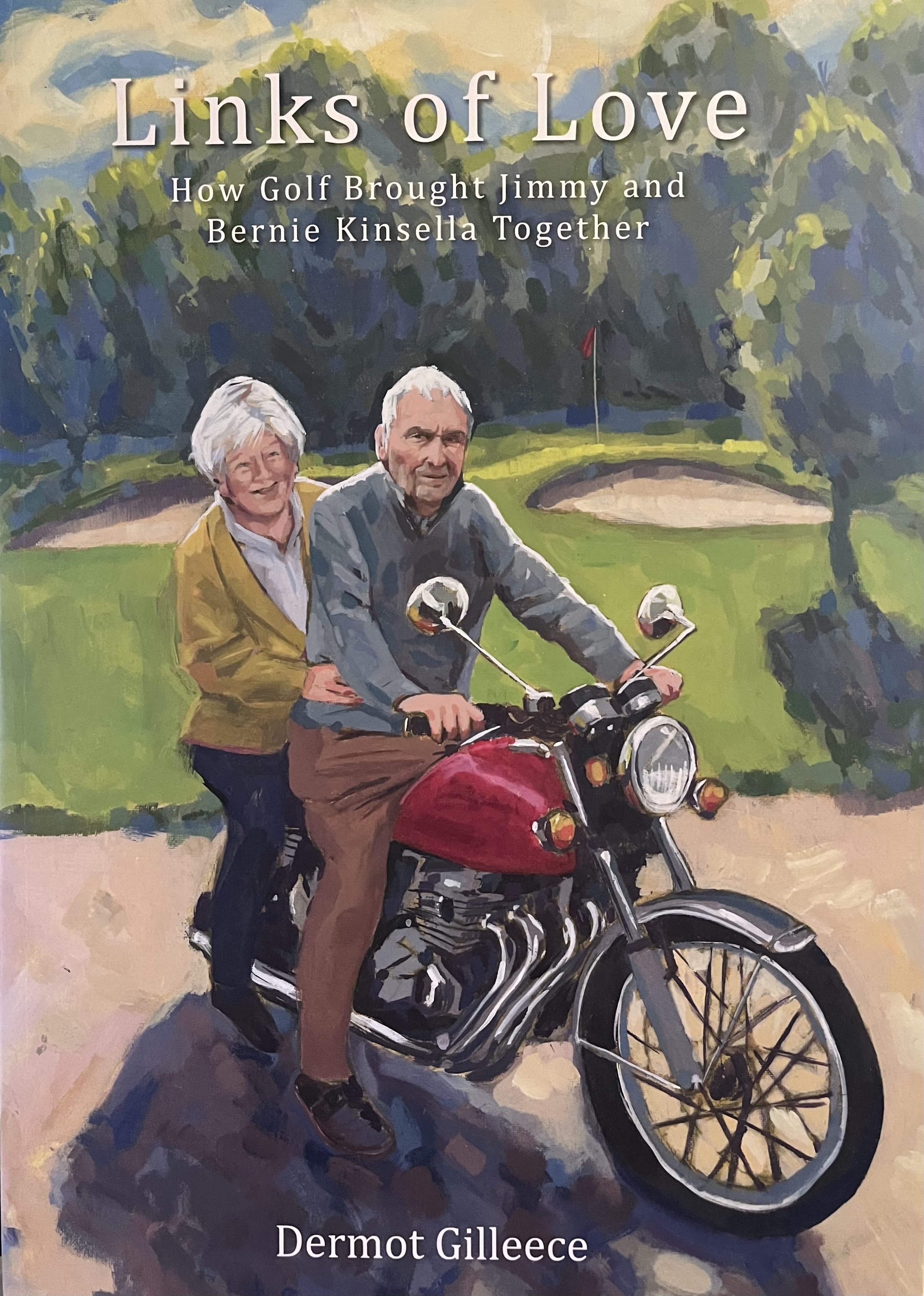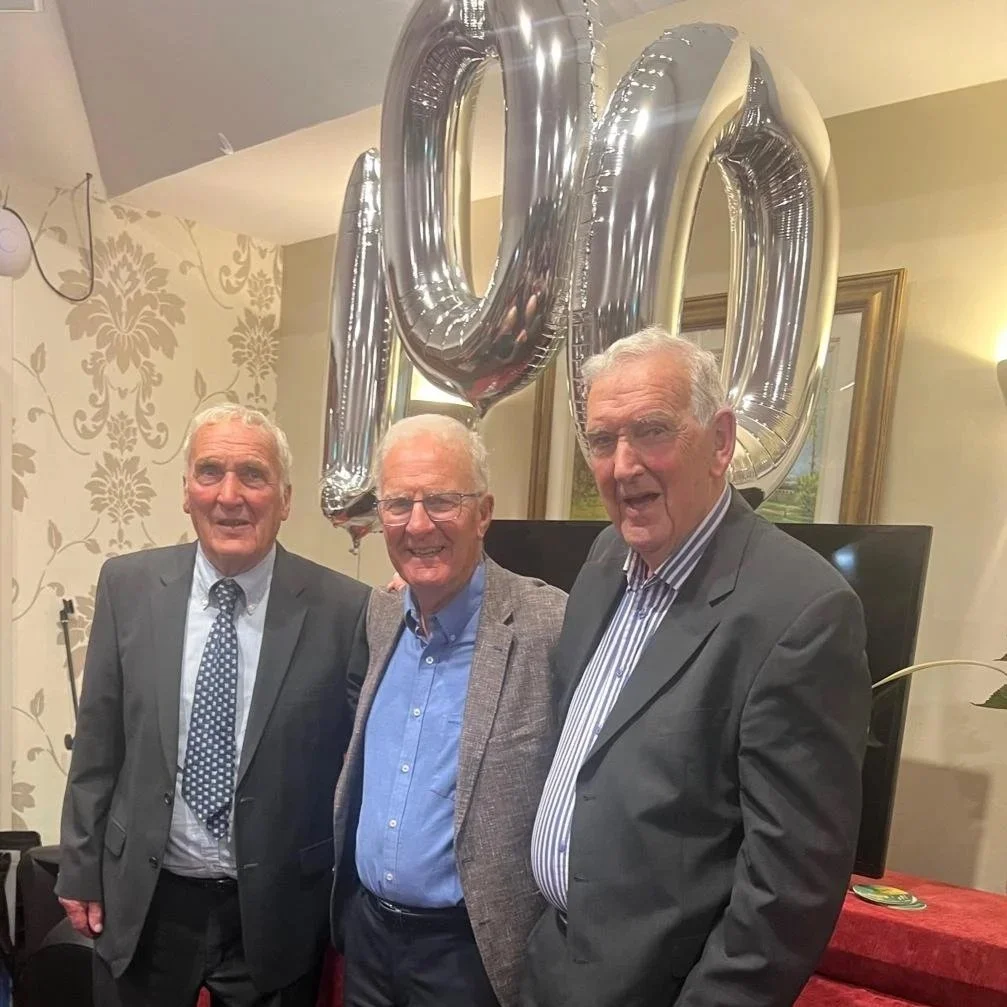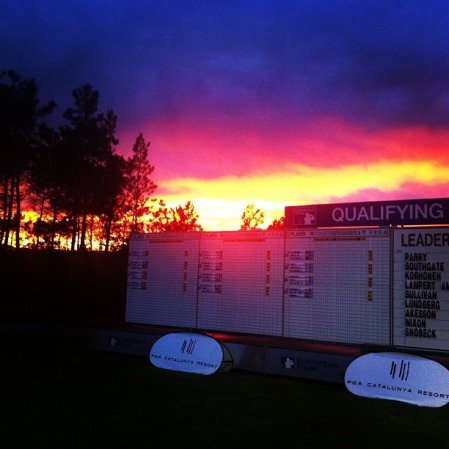Who's that with Jimmy Kinsella? A brief history of some Irish golfing royalty

Who's that with Jimmy Kinsella? Prince Juan Carlos of Spain, who announced his abdication at King just this week, presents the winner's cheque to Jimmy Kinsella at the 1972 Madrid Open.
In its essence, theirs is the story of Irish professional golf over the past century - a story of hardship and joy, of love for the game, of friendships, of persimmon and glue, of rubbing shoulders with the greats and beating them occasionally. Added together, the golfing lives of three generations of Kinsellas are so replete with great tales than even the seemingly mundane stories take on epic proportions.
Little did Bill Kinsella realise when he completed his apprenticeship at clubs such as Greystones, Milltown and Enniskillen and took over from Jimmy O’Hare at a then nine-hole Skerries Golf Club in 1930 that his sons Jimmy, Billy and David and his grandson, Bobby, would follow in his footsteps as highly respected PGA professionals.
A Spanish newspaper report of Kinsella's win on the final hole.
The siren call of the sea proved too much for the eldest boy Seán, who bought a trawler with help from his father and a guarantee from former Taoiseach and Skerries stalwart Seán Lemass and did not take to the game again until he was in his 40s.
And so it fell to the other three boys to take on the mantle, not simply because they loved the game, which they did, but because it was the only outlet available to them in the Ireland of the late 1940s and 50s, when money was scarce and the only way into the game was to join the professional fraternity.
“I always wanted to be a pro,” says Jimmy, who enjoyed the most successful playing career of the three with the highlight coming at Club de Campo in 1972 when he became the first Irishman to win on the fledgling European Tour by claiming the Madrid Open with the future King Juan Carlos looking on. The memory of what he said in his speech has faded with time but as he clutched an envelope stuffed with 250,000 pesetas in cash (around £1,500) and stood next to Juan Carlos Alfonso Víctor María de Borbón y Borbón-Dos Sicilias, this humble Skerries professional had every right to marvel at the twists and turns of life.
“There was nothing else. You couldn’t become a member because you weren’t of the right kind to be a member of a golf club. You just couldn’t get in. Back in my time, the Christy Greenes, the Jimmy Martins, the Nicky Lynchs, the Murphys, everyone, we were all caddies. We wanted to play golf and the only way into it was to become an assistant and go on to become a pro.”
The rest is history, as they say. But what a story. If you were to check the golf betting on the Kinsellas making such a huge mark on the game, you would have got very generous odds.
Jimmy Kinsella in full flow
Jimmy’s dislike of school led to him turning professional at the tender age of 15, when he headed to the boat at North Wall to sail away to begin his apprenticeship under the great teacher Bill Cox at Fulwell Golf Club near Twickenham in London.
“Joe Carr had recommended me to Mr Cox, so I went to get the boat and my mother was there and she saw my face and she said, ‘You don’t have to go.’ And I said, ‘If I stay, do I have to go to school?’ And she says, ‘You do.’ And I said: ‘I’m going.’ “
Jimmy laughs at that memory but then adds: “There were tears in her eyes but I had to go. I couldn’t bear school. I hated it. I got paid £2 a week there and my digs were £3. I had to get a pound sent from home every week.
“The biggest worry I had every week was to get the money to go to Mass. I needed a few pennies for the plate. I was depending on thruppence or sixpence tip for carrying the clubs up from the practice ground. I didn’t have a penny in my pocket. There was never a jingle in my pocket. Never.”
As the history of Skerries Golf Club recounts: “Off the course, he was ‘something else’ with a childish love of pranks and practical jokes ranging from the bizarre to the mad. It would take a book to relate them all. The first tee knows when he is present and if announcing your presence to all assembled doesn’t put you off, a football can suddenly land as you are about to swing.
“Fresh ‘devilment’ could be seen in his eyes, but for all that he commanded great respect in the wider golfing fraternity and there is no doubt that, like his father before him, he has been a great ambassador for the club.”
Jimmy admits that he lasted just three months in London when the reserve Liverpool goalkeeper, who had been taking lessons at Fulwell, gave him a lift to Sunningdale to watch a tournament one Saturday afternoon.
“Harry Bradshaw and Christy O’Connor were there - I wasn’t looking for them - and Christy came over because he knew me and asked what I was doing in London.
“He said, ‘Do you like it?’ And I said, no. I hated it. So he said, ‘Will you come to me [in Bundoran]? Ask your dad if you can come to me.’
“There was no phone at home so I wrote a letter to my father and went up to Christy in Bundoran in 1955.”
David Kinsella
Having spent a year learning to play the game at the knee of the master in Bundoran - “we played all the time, Christy would shut the shop and away we’d go” - Jimmy went on to Killarney and from there to Rush to work on the golf course his father designed before becoming apprentice to the great Harry Bradshaw at Portmarnock in 1958-59.
In 1960 he moved to Castle as assistant to Willie Holley and took over as head professional in 1966, when younger brother David came on board as his assistant. David became head professional when Jimmy went on tour in 1972 and remains in the post today as one of the most respected teachers in the history of Irish golf with a who’s who of great players on his CV, including future European Tour winners Paul McGinley, Damien McGrane and Peter Lawrie.
One only has to watch him in action in his shop at Castle for 15 minutes on a busy Saturday morning to realise the great affection and appreciation the members have for him after close to half a century at front of house. The same could be said for his elder brother Billy, the third of the Kinsella boys to take to the professional ranks.
Working at Wavin Pipes at the time, he was about to turn 21 and double his wages from £3 a week to £6 when a call came from Woodbrook professional Pat O’Connor to become his assistant.
“It paid £3 ’10 a week, so I took a huge cut in wages and I wasn’t happy about it,” Billy recalls with a smile. “But I was there from 1963 to ’68 as an assistant and I got the full job in 1968 and remained there for 44 very happy years until 2006. Golf has been good to us.”
It is a tribute to old Bill Kinsella that Jimmy’s proudest golfing moment was not his win in Madrid, his World Cup appearances, his two Irish Professional Championship victories or his third place (alongside Greg Norman) to winner Hubert Green and runner up Ben Crenshaw in the 1977 Irish Open at Portmarnock. Winning the Moran Cup at The Curragh in 1968 takes pride of place.
“It meant a lot to the Da’,” Jimmy says. “He’s lost in the final when the Moran Cup was a matchplay event, so my mother said I had to come down to the club with the Cup. He was pleased as punch about it. I loved him altogether. He was a great man and spent all his time giving lessons in Skerries in the summer time and trying to earn a few shillings to rear us. He never drank or smoked, because he could’t afford to.”
Billy goes on: “He was a great man. He had hardship. If me or Jim or David think we had any hardship in our jobs, it was nothing compared to what those old pros went through.”
Born too soon to take advantage of the huge wealth available to the successful tour professional today, Jimmy was still a respected player. He loved the camaraderie of it all and to learn from the greats.
Jimmy and David during filming for a DVD about the centenary of Castle Golf Club
“There were people like Neil Coles and Bernard Hunt and Peter Butler and Dai Rees - a real gent - Max Faulkner, Jimmy Adams,” Jimmy remembers. “All the old guys. And they were real gentlemen, lovely people. Harry Weetman. Peter Thomson. All those guys were great to play with and I really looked forward to playing with them. You’d watch the good fella when you were playing with him but you wouldn’t watch the bad fella.”
Five-time Open champion Thomson once told Jimmy that he’d find life tough if he ever left the tour.
“He said to me, ‘The wandering will always be in you.’”
Yet even when heart trouble forced him to cut short his tour career in 1976, the golfing gods had a plan. Jimmy took over from his father Bill when he retired after 46 year as head professional at Skerries and remained there for another 30 years, when his son Bobby took over in 2006.
The wandering may always be in him, but home is where the heart is and the Kinsellas, PGA professionals to the core, remain at the heart of Irish golf.
It all goes back to Skerries, of course, as David recalls.
"Skerries was brilliant. I played football, gaelic, soccer and rugby. I won the Joe Carr Trophy at Bettystown the first time it was played and then in 1963 I won the Lord Mayor’s Cp and the Barton Cup with Skerries. That’s all I ever did as an amateur. I came here at 16 to be the assistant to Jimmy.
"For whatever reason, I thought I was good but it never happened for me as a tournament player so I became the pro here at 22 because Jimmy was keen on playing the tour. They offered me the job on the proviso that I didn’t travel the world.
"I became the Leinster coach for 12 years, I was captain of the PGA in 1984. But I loved teaching and it was very rewarding working with players like Paul McGinley and many others.
"Of course the professional's job has changed greatly since my father began. He was the greenkeeper, he was making clubs, repairing clubs, giving lessons. Now the golf is more administration. But in my dad’s day, pros were looking after the caddies, the golf course, telling the workmen what to do, and making and repairing clubs.
"Jimmy would have been hot into repair work and I wasn’t. When I came around, leather grips were on the way out and we brought all the repairing and polishing to Mick Murphy in Royal Dublin and Mick and Andy did all our polishing and things like that. I would be hopeless."
Speaking in his home in Skerries, Jimmy Kinsella talks to local radio about the Kinsella family's remarkable 82-year connection with Skerries Golf Club
The story of Jimmy's Madrid Open win is still fascinating to this day and David has his take.
"He arrived in Madrid not feeling very well and said, I’ll play now that I’m here. He didn't have a caddie and didn’t want a local caddie. He carried his own bag and got a decent caddie when the cut came. When he was playing his best, he would just stand up and hit the ball. He would hardly take a little swish. He’d barely look at the putt. When he was leading by one going up the 18th in Madrid, he had a short shot in and walked forward to suss the shot out.
"That’s something that he’d never do. He left it on the front and the flag was well in. He left himself a lot of work to do but got the two putts and apparently and apparently Prince Carlos came running down and embraced him. People thought he was very refreshing, just walking up and hitting the ball, carrying his own clubs."
Jimmy's son Bobby, the current professional at Skerries
Jimmy himself remembers the aftermath of the Madrid win, especially the flight home.
"Jack Newton was on the plane and I had filled the cup and Jack had had a few drinks and he looked at the cup and he looked at me and says, 'Jimmy, that’s all I ever want to do. If I could win a tournament like you did. That’s my ambition in life. To win one event. If I could win one event I could die happy.' Of course, he nearly won the British Open in '75 only lost in the playoff to Tom Watson."
As for the story of Jimmy hitting a wedge off a green at St Andrews, it's perfectly true according to David.
"He took a sand wedge out in St Andrews on the 17th, blocked out by the bunker. An official said, you can’t do that. And Jimmy said, what do you mean I can’t do that. Just effing watch me. And he nipped it up to there and said, now can’t I."
The family is full of characters but their father's memory remains a constant.
"My father was a great character, lovely man," David says. "On Christmas morning after Mass, Jimmy, Billy, myself and our dad would go up and have nine holes. Sean would be there. He wouldn’t play. He gave up from the age of 15 until he was 40. He had to go working to keep the rest of us playing golf and farting around. He worked on a farm first and then worked fishing with the help of my dad and Sean Lemass, who went guarantor for the boat."





